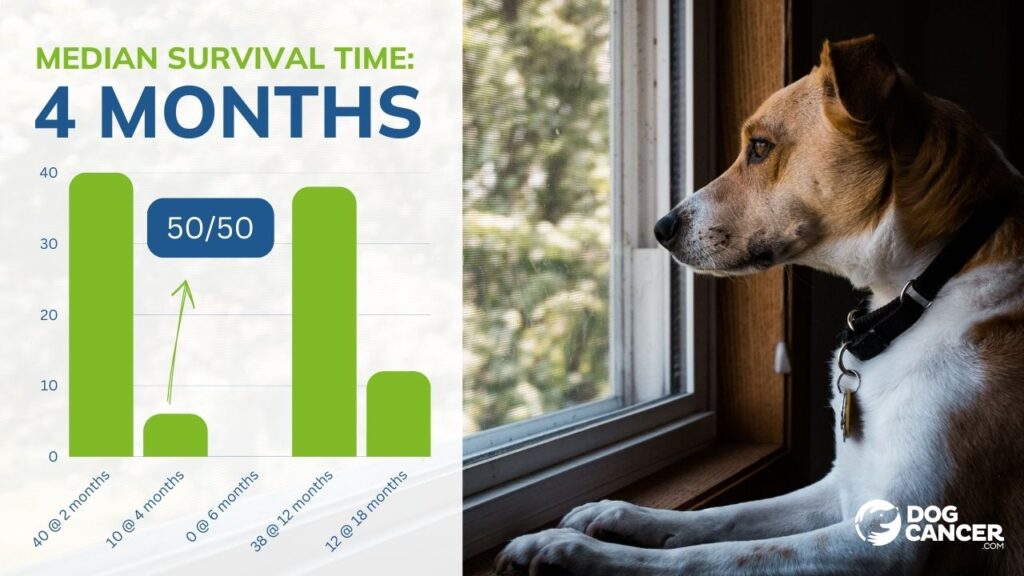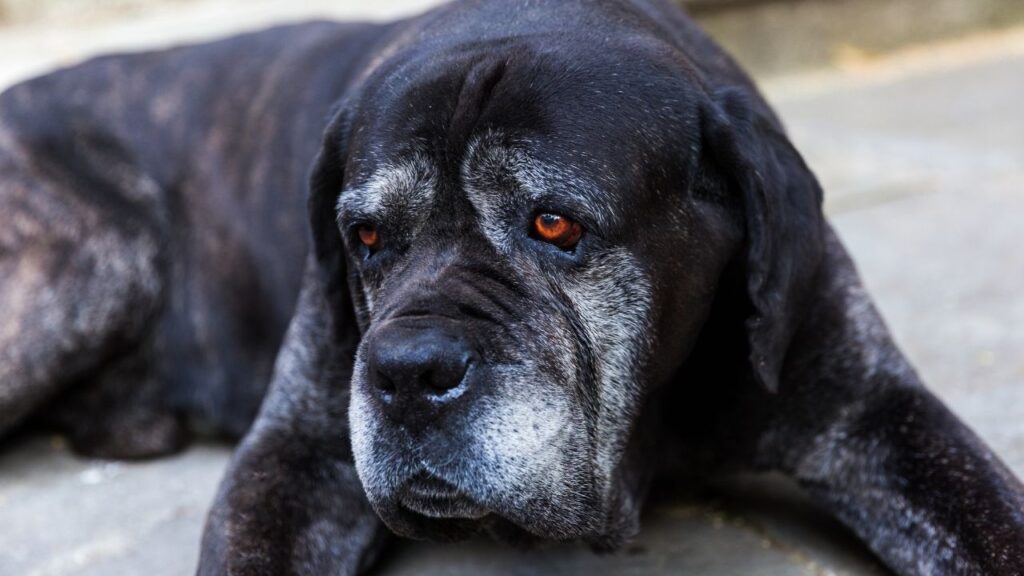Histiocytic Sarcoma
Histiocytic sarcoma is a rare but stubborn dog cancer. There are some early signs of hope that advances in chemotherapy, and immunotherapy-based treatments will provide better treatment options. In the meantime, if you treat it aggressively, outcomes significantly improve.
Histiocytic Sarcoma: An Uncommon Immune System Cancer in Dogs
Histiocytic sarcoma (HS) is a group of malignant cancers that arise from histiocytes. It is an uncommon cancer, but it is overrepresented in certain breeds, suggesting a heritable element. Histiocytic sarcoma typically occurs in middle aged and older dogs.
What Are Histiocytes?
Histiocytes are white blood cells that inhabit connective tissues and normally protect tissues from damage by foreign substances and infection.2 Histiocytes can be classified as dendritic antigen-presenting cells (DAPCs) or macrophages.3
Histiocytic sarcoma that starts from dendritic cells can be localized or disseminated,4 while histiocytic sarcoma that starts from macrophages is the hemophagocytic form of histiocytic sarcoma (the most aggressive type of this cancer). Macrophages are cells involved in the inflammatory process that are capable of phagocytosis, a process in which a cell can engulf particles.3 DAPCs are mostly incapable of phagocytosis and play a role in presenting antigens to trigger an immune system response.3
Localized Histiocytic Sarcoma (LHS)
Localized histiocytic sarcoma grows rapidly as a solitary, locally invasive soft tissue mass.3 The primary tumor most commonly develops in the skin or the subcutis (the fatty layer just beneath the skin) of the extremities. These tumors often will grow to invade the deeper layers of skin and underlying muscle and fascia.3
Localized histiocytic sarcoma can also develop in joints, lymph nodes, the spleen, lungs, or bone marrow.4
When found in joints, it often encircles the joint and involves tendons, the joint capsule, and muscle.3
Primary lesions may also be found in the brain or nasal cavity.3
Localized histiocytic sarcoma has a 60% metastatic rate.3
Disseminated Histiocytic Sarcoma (DHS)
Disseminated histiocytic sarcoma is the preferred term for the cancer historically known as malignant histiocytosis.3 This is an aggressive, multisystem disease characterized by multiple tumors in several organs. The spleen, lung, and bone marrow are often primary sites, with the liver and lymph nodes often affected by metastasis.3
The more aggressive form of disseminated histiocytic sarcoma is classified as hemophagocytic histiocytic sarcoma, which is thought to arise from spleen and bone marrow macrophages.1
This form has a higher metastatic rate and is differentiated by immunohistochemical staining of macrophages (special staining done in a pathology lab).
This form is thought to be more aggressive because of its ability to phagocytize, or consume, other cells, including important ones such as red blood cells.5
This aggressive disease spreads quickly, and unfortunately, death typically occurs weeks to months after diagnosis.
Stats and Facts
- Histiocytic sarcoma is rare, representing less than 1% of canine cancers of the lymphatic system.5
- Although overall still rare, histiocytic sarcoma is the most common tumor around dogs’ joints.6
- Histiocytic sarcoma accounts for 5% of primary brain tumors and 4.5% of metastatic brain tumors in dogs.6
- Three subtypes of histiocytic sarcoma have been identified based on the cell of origin and the clinical presentation of the disease. These include localized histiocytic sarcoma, disseminated histiocytic sarcoma, and hemophagocytic histiocytic sarcoma.4
- 18.3% of cases are located in the bone or joints.4
What Causes Histiocytic Sarcoma in Dogs
There is no known cause of histiocytic sarcoma, though a few breeds are overrepresented. A genetic mutation has been identified in the Bernese Mountain Dog.2, 3
Risk Factors for Canine Histiocytic Sarcoma
Certain breeds are affected more commonly by histiocytic sarcoma, suggesting a heritable element. Histiocytic sarcoma usually occurs in dogs 6-11 years of age but has been documented in dogs as young as three.6
The breeds that are predisposed to localized histiocytic sarcoma include:3
- Bernese Mountain Dogs
- Flat-Coated Retrievers
- Labrador Retrievers
- Rottweilers
These four breeds and Golden Retrievers are more susceptible to disseminated histiocytic sarcoma.3
Diana Gerba, a Bernese Mountain Dog fan, tells Tesoro's True Tail in this inspiring DOG CANCER ANSWERS episode.
Bernese Mountain Dogs and Histiocytic Sarcoma
Histiocytic sarcoma is a genetic disease in the Bernese Mountain Dog.2, 3 Berners have been shown to be considerably more likely to be affected by histiocytic sarcoma than other breeds. Reports have suggested that up to 25% of Berners will develop histiocytic sarcoma.7 There may be an association between chronic inflammatory conditions and the occurrence of histiocytic sarcoma in Berners.7
Prior joint disease or preexisting orthopedic disease has also been identified as a risk factor. A correlation between prior joint disease and the risk of histiocytic sarcoma around a joint, periarticular histiocytic sarcoma (PAHS), has been reported in Berners and other breeds.6 Dogs with periarticular histiocytic sarcoma were 2.5 times more likely to have preexisting orthopedic disease in the tumor-affected joint when compared with control populations.6
Symptoms of Histiocytic Sarcoma
The clinical signs that an owner will observe for dogs with histiocytic sarcoma will depend on which organ(s) is involved3 and the subtype.
With localized histiocytic sarcoma, most owners notice palpable masses on or under the skin and the dogs are not systemically ill.3
With disseminated histiocytic sarcoma, signs may be nonspecific and harder to pinpoint. Symptoms can include:2,3
- Decreased appetite
- Lethargy
- Weight loss
- Fever
- Lesions on the skin
- Coughing or difficulty breathing (masses in the lungs)
- Limping (masses in a joint or the bone marrow)
- Neurologic signs including disorientation, wobbly gait, and seizures
- Swollen lymph nodes
- Bulging eyes
- Distended abdomen
Dogs usually show a combination of symptoms because the disease is at an advanced stage and has already affected multiple sites in the body by diagnosis.
Histiocytic Sarcoma Dog Diagnosis
Histiocytic sarcoma is difficult to diagnose and is often confused with other types of cancer. Diagnosis depends on identifying histiocytes and can only be achieved by biopsy of affected tissues.2
Your veterinarian will start with a full physical exam. The most common presenting clinical signs are the presence of a mass (43.2%), lethargy (17.3%), and lameness (11.7%), with the other clinical signs spanning a large spectrum.
Advanced laboratory testing is required to diagnose histiocytic sarcoma definitively and to differentiate between the different types of histiocytic sarcoma. Immunophenotyping is the main way to reach a definitive diagnosis with histiocytic diseases.3 Immunohistochemistry (IHC) is needed to make sure that you are dealing with periarticular histiocytic sarcoma rather than another type of joint cancer. It’s also needed to identify hemophagocytic histiocytic sarcoma definitively.6
Your veterinarian will typically recommend standard diagnostics like blood work and x-rays and may also recommend an ultrasound or CT scan to help identify the extent of the disease.2 Bloodwork may show decreased red and white blood cell counts.
After the basic testing, your vet will likely refer you to an oncologist or schedule a biopsy so that a tumor sample can be sent out for specialized tests to get a definitive diagnosis.
Prognosis and Staging
The histiocytic sarcoma’s prognosis depends on the cancer’s subtype and extent. The prognosis for localized histiocytic sarcoma overall is better than disseminated histiocytic sarcoma, and hemophagocytic histiocytic sarcoma has the poorest prognosis.
How your dog does in the first week can be telling. The median survival time for dogs diagnosed with localized histiocytic sarcoma or disseminated histiocytic sarcoma that survived more than seven days after diagnosis is 180 days.4
If your dog survived more than 7 days after a localized histiocytic sarcoma diagnosis, their median survival time is 180 days.
Dogs diagnosed with localized histiocytic sarcoma appear to have a better prognosis when treated compared to dogs diagnosed with disseminated histiocytic sarcoma:3,4
- Localized histiocytic sarcoma has median survival times of up to 398 days.
- Dogs with localized histiocytic sarcoma in the joint have a poorer prognosis, with a median survival time of about 5 months with aggressive treatment (amputation and chemo). This cancer has a 91% metastatic rate.
- Disseminated histiocytic sarcoma has median survival times of 78 days.
Definitive treatment of localized histiocytic sarcoma was associated with a prolonged survival time in many studies, with median survival times of about one year. Palliative treatment of localized histiocytic sarcoma has a 39-day median survival time. Dogs treated beyond palliative care with disseminated histiocytic sarcoma had a median survival time of 85 days.4
Using a corticosteroid as part of the treatment plan is associated with decreased survival times.4 Dogs receiving definitive treatment for localized histiocytic sarcoma in combination with corticosteroids had a median survival time of 170 days, versus a 394 median survival time in dogs receiving definitive treatment only.4 In dogs with periarticular histiocytic sarcoma (cancer in the joint), prednisone significantly shorted time to tumor progression and death.2
Staging Histiocytic Sarcoma to Move Quickly
For dogs with histiocytic sarcoma that cannot be treated with surgery or those with extensive metastasis, death or euthanasia often occurs within days or weeks of diagnosis.5
Dogs with the hemophagocytic form of histiocytic sarcoma usually have a short survival time of a few weeks.
Staging is determining the extent and severity of your dog’s cancer. This information may impact which treatments your veterinarian recommends and which you decide to pursue with your dog. Having the complete picture of your dog’s cancer will allow you to make educated decisions about how to proceed.
With localized histiocytic sarcoma, staging includes chest and abdomen imaging to assess organ involvement. This includes chest x-rays and abdominal ultrasound, which also helps to differentiate from disseminated histiocytic sarcoma.3
Other tests used in staging include aspiration of regional lymph nodes and bone marrow.3
Staging for disseminated histiocytic sarcoma includes the same diagnostics as localized histiocytic sarcoma. In addition, aspiration of abdominal organs such as the liver and spleen may be needed to differentiate from nonhistiocytic disease.3
The staging tests for hemophagocytic histiocytic sarcoma are the same as disseminated histiocytic sarcoma.4
Treatment
Because of the highly aggressive nature of histiocytic sarcoma, effective treatment of this disease often requires both local and systemic therapy, even for localized forms. Disseminated forms are generally treated with systemic therapy (chemotherapy) only.6
Any form of treatment beyond pain management or corticosteroids significantly improved outcome regardless of metastatic status.1 Despite reported metastatic rates of 70–91%, treatment for dogs with histiocytic sarcoma consisting of surgery, radiation, chemotherapy, or a combination appears to improve survival outcome.
Surgery
Surgery is most useful for localized histiocytic sarcoma.
Aggressive surgical resection is recommended for localized histiocytic sarcoma with wide, 3 cm (about 1.18 in) lateral margins and a deep margin of at least one fascial layer.3 Limb amputation is recommended for histiocytic sarcoma in a joint that hasn’t spread.3
In dogs with disseminated histiocytic sarcoma, surgery provides only palliative relief and is seldom curative for this cancer type because microscopic spread to other organs has usually already occurred (metastasis). Surgery is not recommended unless it will provide palliative benefit.1 Removal of a larger mass like a splenic tumor may provide a certain degree of comfort but the surgery is invasive, requires a recovery period, and will not be curative.
Chemotherapy
Chemotherapy may sometimes prolong survival time; however, the prognosis is still poor. Chemotherapy is recommended but may not be very effective in many cases.3 CCNU (lomustine) is currently considered the most effective chemotherapy for histiocytic sarcoma, with studies showing a 46% response rate.5,6
Let’s break down what we know about histiocytic sarcoma and CCNU a little more:
- Lomustine after surgery improved median survival times to 19 months for localized histiocytic sarcoma.3
- For disseminated histiocytic sarcoma, lomustine improved median survival times to 5.5 months for 54% of dogs in the study.5
If treatment is unsuccessful with CCNU, other protocols have been tried but have not shown to be more beneficial.
- Alternating doxorubicin with CCNU showed a 58% response rate with a median time to tumor progression of 6 months.6
- Protocols using epirubicin combined with CCNU, dacarbazine, and vinorelbine showed stable disease for a median of only about two months.6
- In a study using vinorelbine, two of nine dogs had a partial response for much longer, one for five months and the other for two years.6
- The use of bisphosphonates (eg, Liposomal clodronate) was effective at inducing apoptosis (natural cell suicide) in histiocytic sarcoma cell lines. Liposomal clodronate was then shown to elicit significant tumor responses in two of five dogs with histiocytic sarcoma. Results of larger studies are not yet available.2, 6
Further studies are needed to understand the efficacy of other chemotherapy agents in treating histiocytic sarcoma.
Radiation
Radiation may be used to treat localized histiocytic sarcoma in several cases:3,6
- Pre-operative irradiation of large tumors
- Post-operative irradiation of incompletely removed tumors
- Palliative irradiation of inoperable tumors
Chemotherapy combined with radiation has demonstrated limited success. Dogs treated with a combined protocol of palliative radiation and lomustine (CCNU) had a median survival time of approximately seven months.6
Targeted radiation for internal masses has shown a moderate success rate but is not curative.6 Further investigation is warranted to determine optimal protocols. Dogs treated with radiation survived a median of 182 versus 60 days for those that were not.8
Immunotherapy
Initial studies have shown promise for the use of T-cell therapy in disseminated histiocytic sarcoma. Durable clinical remissions and prolonged survival have been documented in four histiocytic sarcoma dogs who were treated with a human T-cell immunotherapy treatment called TALL-104.9
Vaccine
There is currently no vaccine available.
Diet
There are no specific dietary recommendations for dogs with histiocytic sarcoma. The most important thing when feeding a dog with histiocytic sarcoma is to ensure the diet is complete and balanced, providing all of the nutrients required by a dog.
Supplements
There are no supplements specifically recommended for histiocytic sarcoma. However, a variety of foods, plants, and herbs support the immune system and may help in your dog’s fight against cancer.
Always consult your veterinarian before adding a supplement to ensure it is a good fit for your dog and won’t interfere with any medications or treatments. Natural and herbal remedies often lack scientific support but have anecdotal success stories. Especially when slowing the growth of the rare cancer histiocytic sarcoma, you may need to rely on your veterinarian’s educated perspective.
Integrative Therapies
Physical therapy and rehabilitation, including hydrotherapy, treadmill, and passive range of motion exercises, may be helpful if movement is compromised, particularly following limb amputation.
Acupuncture has not been studied for histiocytic sarcoma but can help with comfort levels.2
Though often not proven with controlled scientific and clinical trials, there is anecdotal support for the use of acupuncture, acupressure, and traditional Chinese medicine in targeting the tumor and the symptoms of cancer treatment.

What the End Stages of Histiocytic Sarcoma Look Like
Dogs with disseminated histiocytic sarcoma may be so sick at diagnosis that you may need to choose euthanasia quickly. There is a likelihood of rapid deterioration, so even if you don’t feel called to do this right away, you may soon after you get the bad news.3 The clinical course of this disease is rapidly progressive, with a life expectancy of one to six months after diagnosis.
Palliative care to relieve the symptoms associated with histiocytic sarcoma is commonly elected to help relieve these patients until they succumb to their disease or are humanely euthanized.
The clinical signs of weight loss, lethargy, pain, and discomfort are progressive and difficult to manage, which often prompts a quality-of-life discussion for a family.
Prevention Strategies
Unfortunately, there is no known prevention strategy for histiocytic sarcoma. Since this is a genetic disease in the Bernese Mountain Dog, before you breed your dog or purchase a Berner puppy, it is critical to ask about their bloodline’s health, longevity, and cause of death.
Topics
Did You Find This Helpful? Share It with Your Pack!
Use the buttons to share what you learned on social media, download a PDF, print this out, or email it to your veterinarian.









